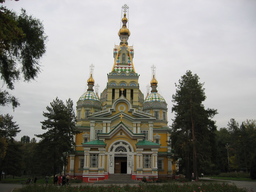
Zenkov Cathedral, Alma-Ata
2004.10.08 Alma-Ata, Kazakhstan
 Zenkov Cathedral, Alma-Ata |
I'm in the land of Roquefort cheese, cinnamon rolls, and proper socks. Relative to what's available in China, these are the items I've been happiest to purchase since arriving in Kazakhstan. I've even found a restaurant with hookahs, so am hoping to replenish my charcoal supply while in town.
The first week of October is free from classes--all of China takes this time off to recognize National Day. Michael is continuing his trip onward to Western Europe; we took the train here directly from Urumqi.
As my mention of cheese and pastries indicates, Alma-Ata feels far more European than anywhere I've been this past year. Last night we attended a performance of Faust at the beautiful new opera house in the center of town. In accordance with my sense of how things are in formerly Soviet countries, admission for floor-level seating was just a few bucks. Over the course of the evening there must have been two-hundred performers involved including the actors, ballerinas, and musicians in the orchestra pit. I'm sure the audience had less people than that. I suppose that's not much of a surprise. The schedule listed a different performance every night of the month including Madame Butterfly, Carmen, and Don Quixote. With elaborate performances staged nightly, I can see why the local population can be indifferent about attendance.
At the center of Alma-Ata's Panfilov Park is the Zenkov Cathedral, the site which has made me feel furthest away from this past year in China. I have previously visited other active churches in Russia's major cities and--while the decor and rituals at Zenkov are not unique--stepping into a Russian Orthodox church always captures me with a certain mystical sense when I enter.
The interior is dimly lit, despite perhaps two-dozen candelabras about the place, each resting on a golden stand in front of the picture of a saint. The surrounding walls are covered by the names and images of saints, the colors and Cyrillic script of which ebb with the flickering of hundreds of candles. The back of the main chamber finds a priest reading the mass aloud in rapid Latin. Four women, heads shrouded in scarves, punctuate out a harmonious accompaniment.
Priests wear long yellow robes and sashes. One occasionally wanders the fringes of the room, swinging a pot of smoking incense from a chain. Worshippers kneel, then prostrate themselves on the ground at the appropriate points in the sermon. They often form the sign of the cross, gesturing towards head, heart, and shoulders: this is done as a mirror-image of the hand motions followed by Roman Catholics. Most of the floor is bare cement, though strips of decorative tilework add flourish. While not elaborately constructed, the windows are nonetheless made of stained-glass; several chandeliers dangle from above.
I hadn't planned to visit the cathedral, but wound up entranced inside for an unknowable length of time.